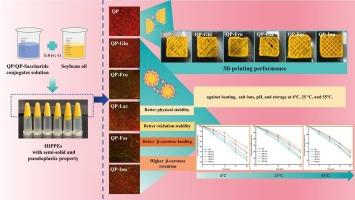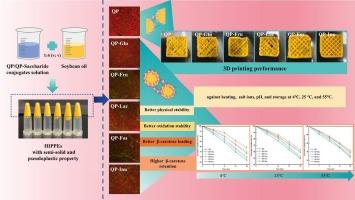Development of quinoa protein-saccharide conjugates stabilized high internal phase Pickering emulsions for 3D printing and β-carotene delivery
IF 9.8
1区 农林科学
Q1 CHEMISTRY, APPLIED
引用次数: 0
Abstract
High internal phase Pickering emulsions (HIPPEs) exhibit great potential in 3D printing and the delivery of hydrophobic compounds due to their semi-solid rheological properties and high oil phase volume. In this study, quinoa protein-saccharide conjugates were used to stabilize HIPPEs as 3D printing inks for the delivery of β-carotene. The quinoa protein-inulin conjugate (QP-Inu) demonstrated a larger three-phase angle approaching 90°, lower interfacial tension, and a higher absorption rate, resulting in a compact network structure with more tightly packed smaller droplets, as confirmed by particle size and confocal laser scanning microscopy (CLSM) analysis. All HIPPEs exhibited solid-like viscoelasticity and shear-thinning behavior. Among these, QP-Inu stabilized HIPPEs displayed higher viscosity and elasticity, superior thixotropic recovery rates, and enhanced 3D printability with improved accuracy and self-supporting ability. Furthermore, QP-Inu stabilized HIPPEs showed a better encapsulation capacity for β-carotene and superior storage ability, and stability against adverse environmental stresses, including pH, heating, salt ions, and oxidation. In conclusion, quinoa protein-saccharide conjugates can be promising candidates as stabilizers to form food-grade HIPPEs as new 3D printing materials and effective β-carotene delivery system.


用于3D打印和β-胡萝卜素递送的藜麦蛋白-糖偶联物高内相皮克林乳液的研制
高内相皮克林乳液(hipes)由于其半固体流变性能和高油相体积,在3D打印和疏水化合物的输送方面表现出巨大的潜力。在这项研究中,藜麦蛋白-糖偶联物被用来稳定hipes作为3D打印油墨,用于输送β-胡萝卜素。藜麦蛋白-菊糖共轭物(QP-Inu)具有接近90°的较大三相角、较低的界面张力和较高的吸收率,通过粒径和共聚焦激光扫描显微镜(CLSM)分析证实,该共轭物具有紧凑的网络结构,具有更紧密的小液滴。所有hipes均表现出固体样粘弹性和剪切减薄行为。其中,QP-Inu稳定的hips具有更高的粘度和弹性,优越的触变回收率,增强了3D打印能力,提高了精度和自支撑能力。此外,QP-Inu稳定的hipes对β-胡萝卜素具有较好的包封能力和较好的储存能力,并且对pH、加热、盐离子和氧化等不利环境胁迫具有稳定性。综上所述,藜麦蛋白-糖偶联物可以作为稳定剂形成食品级hipes,作为新的3D打印材料和有效的β-胡萝卜素递送系统。
本文章由计算机程序翻译,如有差异,请以英文原文为准。
求助全文
约1分钟内获得全文
求助全文
来源期刊

Food Chemistry
工程技术-食品科技
CiteScore
16.30
自引率
10.20%
发文量
3130
审稿时长
122 days
期刊介绍:
Food Chemistry publishes original research papers dealing with the advancement of the chemistry and biochemistry of foods or the analytical methods/ approach used. All papers should focus on the novelty of the research carried out.
 求助内容:
求助内容: 应助结果提醒方式:
应助结果提醒方式:


